Chapter 8 - Transport Across Membranes
1/40
There's no tags or description
Looks like no tags are added yet.
Name | Mastery | Learn | Test | Matching | Spaced |
|---|
No study sessions yet.
41 Terms
Homeostasis
Simple Diffusion
Gases, nonpolar molecules, small polar molecules (water, glycerol, ethanol)
Facilitated Diffusion/Passive Transport
Can become saturated at high solute concentrations because there are a limited number of transport proteins
Active Transport
Transport against concentration gradient (Low concentration to high concentration); requires ATP
Bulk Transport
Movement of large molecules. Endocytosis (into cell) & Exocytosis (Out of cell)
Rates of Solutes Crossing Lipid Bilayer
Small, nonpolar molecules - Fast; readily diffuse
Uncharged polar molecules - Fast; readily diffuse if small enough
Ions - NONE; needs transport proteins/channels
Exergonic Vs. Endergonic
Simple & facilitated diffusion (release of energy)
Active Transport (input of energy)
Electrochemical Potential
the combined effect of an ion’s concentration gradient
Membrane Potential (Vm)
charge gradient across a membrane
Most cells have an excess of ____ charged solutes ___ the cell.
negatively; inside. This charge favors the inward movement of cations (Na+) and the outward movement of anions (Cl-)
Thermodynamic equilibrium
No further net movement occurs because the free energy of the system is at a minimum
Osmosis
movement of water
Water will move towards
the region of higher solute concentration. For most cells, water tends to move inward.
Osmolarity
total solute concentrations inside versus outside of the cell
Hypertonic
solute concentration is higher outside the cell
Hypotonic
solute concentration is lower outside the cell
Isotonic
same solute concentration inside and outside the cell
Plant Cells & Turgor Pressure
Cell walls keep a cell from swelling and bursting in a
hypotonic solution. Turgor pressure is the pressure that pushes plasma membrane against cell wall. Plasma membrane pulls away
from the cell wall by a process called plasmolysis
Cells without cell walls
pump out inorganic ions, reducing the intracellular
osmolarity
Liposomes
small vesicles forming a closed, spherical lipid bilayer lacking proteins
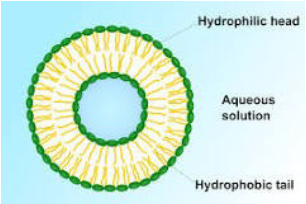
Factors affecting diffusion
size, polarity (separation of charge on a molecule), and charge
If the molecular weight of a molecule is less than ___ it can diffuse across the membrane.
100
Estrogen and testosterone (large nonpolar molecules) cross the membrane ___.
easily.
Partition coefficient
Polarity of a solute can be measured by the ratio of its
solubility in an organic solvent to its solubility in water. The more nonpolar (hydrophobic) a substance is, the higher the partition coefficient
Shell of hydration
For these substances to move into a membrane, the water
molecules must be removed, a process that requires
energy.

Kinetics of Simple Diffusion and Facilitated Diffusion
Facilitated diffusion can become saturated, causing the rate to plateau.
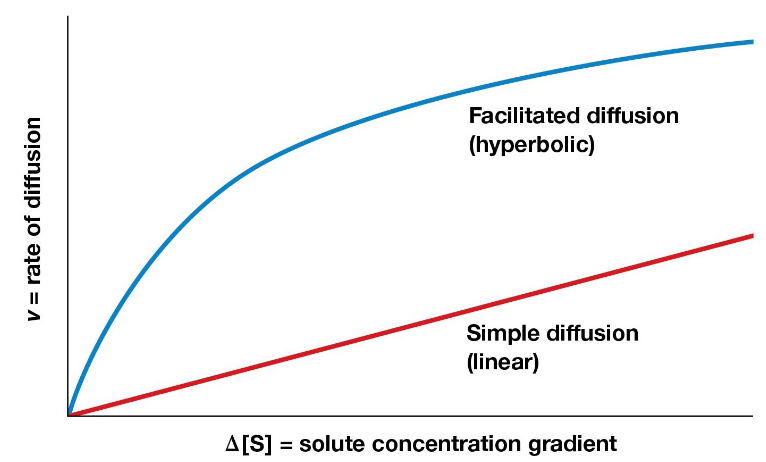
Carrier Proteins
(transporters or permeases) bind solute molecules
on one side of a membrane, undergo a conformation change, and
release the solute on the other side of the membrane
Channel Proteins
form hydrophilic channels through the membrane
to provide a passage route for solutes
Cellular Pores
Pores are formed by transmembrane proteins called
porins that allow passage of solutes up to a certain
molecular weight to pass (600)
Ion channels
The movement of solutes through ion channels is much
faster than transport by carrier proteins. This is likely because conformation changes are not required
Alternating Conformation Model
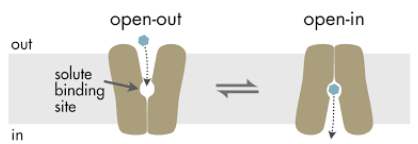
Competitive Inhibition of Carrier Proteins
Competitive inhibition of carrier proteins can occur in the
presence of molecules or ions that are structurally related
to the correct substrate (Example: Glucose Transport Proteins > mannose and galactose)
Uniport
A carrier protein that transports a single solute
Symport
If the two solutes are moved across a membrane in the same direction
Antiport/countertransport
solutes are moved in opposite directions
Channel
forms a pore across the bilayer through which specific
inorganic ions or, in some cases, polar organic molecules can diffuse (can either be open or closed)
Transporter
undergoes a series of conformational changes to
transfer small solutes across the lipid bilayer (are selective)
Passive Transporters Vs. Pumps
Passive = Movement Down Conc. Gradient; NO ENERGY
Pump = Requires ATP; Against Conc. Gradient
Na+/K+ Pump
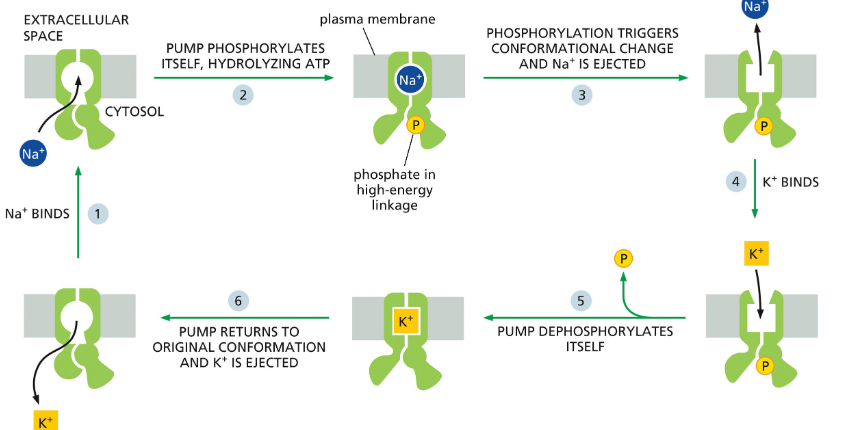
Ca2+ Pump
Keeps the cytosolic Ca2+ concentration low
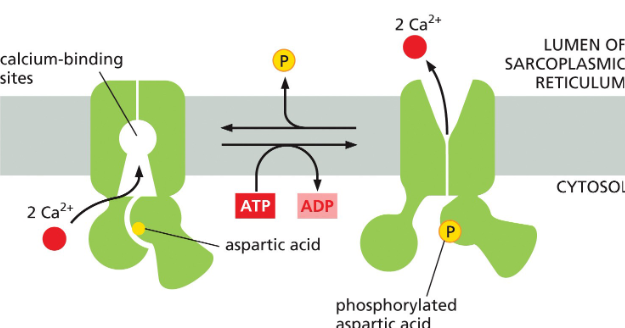
Glucose/Na+ Symport